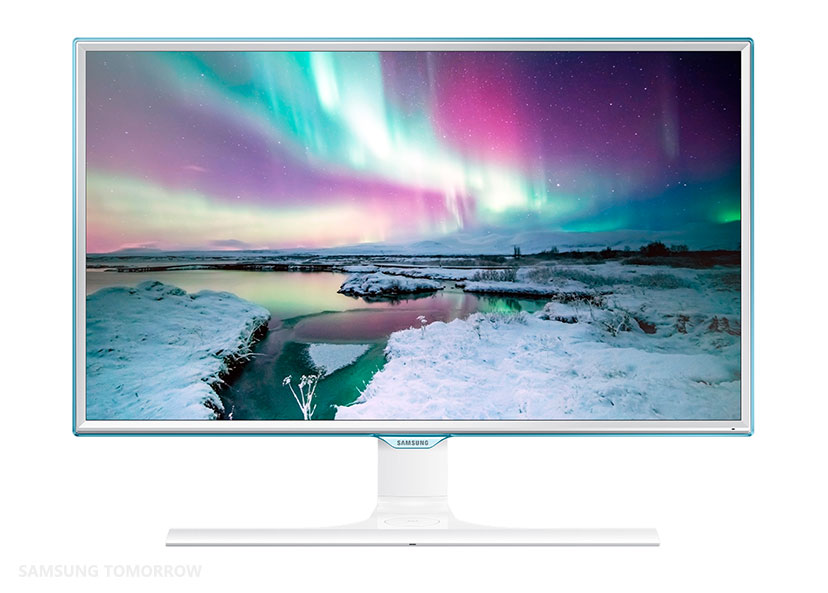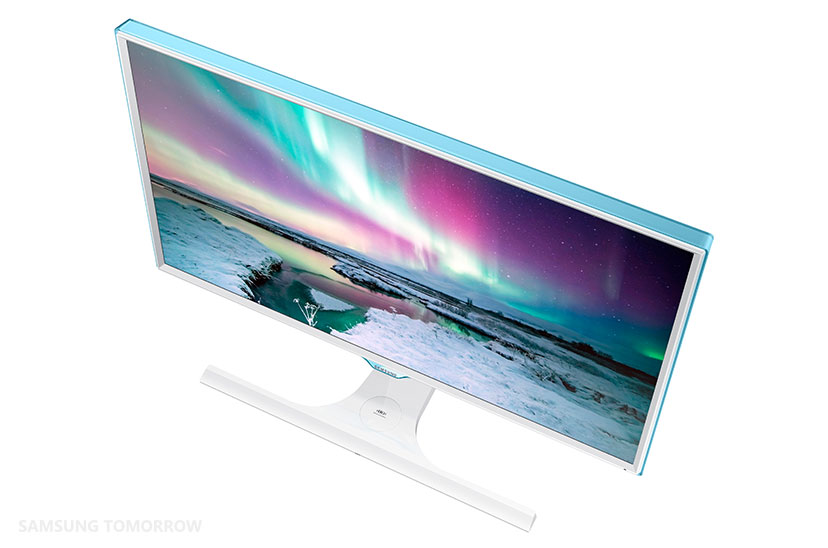Samsung Unveils Monitor With Qi Wireless Charging, Casually Mentions AMD FreeSync Support
Samsung unveiled its new SE370 display, which packs a few special features to help it stand out. Samsung claimed that this is the first display capable of wirelessly charging your mobile devices. It also supports several other key features, including AMD's Freesync technology.
The principal feature in this display is the ability to charge your smartphone wirelessly from the monitor's base using Qi wireless technology. Thus, you don't need to worry about digging out a cable to charge your phone when using this display, as you can just set it on the base, and it will begin charging.
Samsung claimed that this is the first display capable of charging mobile devices in this manner. Any device supporting the Qi wireless charging standard will work with this feature.
"Technology should support, not interfere with, active lifestyles. Our customers increasingly rely on mobile devices to obtain information and interact with others; so by doing away with the clutter on their desks, we are helping them to use their mobile devices in a smarter way," said Seok-gi Kim, Senior Vice President, Visual Display Business at Samsung Electronics in a release. "Through the integration of wireless mobile charging technology, our innovative SE370 monitor dramatically improves efficiency, convenience and connectivity at home and at work – representing another significant milestone in our long history of industry-firsts."
| Header Cell - Column 0 | Feature | S24E370DL | S27E370DS |
|---|---|---|---|
| Display | Size | 23.6" (16:9) | 27" (16:9) |
| Panel Type | PLS | N/A | |
| Resolution | 1920×1080 | N/A | |
| Response Time | 4ms | N/A | |
| Brightness | 250 cd/m2 | 300 cd/m2 | |
| Contrast Ratio | 1000:1 (typical) | N/A | |
| Viewing Angle (H/V) | 178°/178° | N/A | |
| Design | Color | Front/Stand : White High Glossy/C/R : White High Glossy with ToC | |
| Interface | 1 HDMI (1.4), 1 DP (1.2), 1 D-Sub | ||
| OS Compatibility | Windows, Mac | ||
| Essential Features | Wireless Charging, Eco Saving Plus, Magic Bright, Magic Upscale, Game Mode, Eye Saver Mode, Flicker Free, FreeSync, Image Size |
The display will be available in both 23.6-inch and 27-inch models. The resolution of the 23.6-inch display isn't anything special at 1080p, which has become very common today, but the wireless charging isn't the only thing it has going for it. Although Samsung somewhat buried the lede as far as enthusiasts are concerned, it also has support for AMD's FreeSync technology. Although owners of AMD graphics cards are the only ones who can take advantage of this feature, the ability to alter the refresh rate in real time is a major advancement in the world of gaming.
The display utilizes an eye-saver mode, which can reduce blue light coming from the monitor. It is capable of monitoring the environment and the image being processed and adjust it in real-time, and as a result it should help reduce eye-strain.
Inside, we unsurprisingly find one of Samsung's proprietary PLS panels, although this isn't a bad thing by any means. Being related to the IPS display technology, it offers 178 degree viewing angles, a brightness of up to 300 cd/m2, and excellent color reproduction relative to TN panels.
Get Tom's Hardware's best news and in-depth reviews, straight to your inbox.
Finally, the display also has an Eco Saving Plus function that can reduce the overall brightness and other settings that promises a 10 percent reduction in power consumption.
Currently, there is no word on the price or release date of these displays.
Follow Michael Justin Allen Sexton @LordLao74. Follow us @tomshardware, on Facebook and on Google+.
-
InvalidError Unless the display is specifically pitched at gamers, Adaptive Sync support is not really worth mentioning - the rest of the display might not be tuned for high-end gaming and the FreeSync support is only mentioned because the display chipset Samsung used happened to support it. Since Adaptive Sync is a minor update to scaler chips, it will eventually become ubiquitous and hardly worth mentioning anymore.Reply -
therealduckofdeath ReplyUnless the display is specifically pitched at gamers, Adaptive Sync support is not really worth mentioning - the rest of the display might not be tuned for high-end gaming and the FreeSync support is only mentioned because the display chipset Samsung used happened to support it. Since Adaptive Sync is a minor update to scaler chips, it will eventually become ubiquitous and hardly worth mentioning anymore.
Syncing refresh rates has nothing to do with "high end gaming". The more automatic these features gets the easier it will be for normal users to enjoy the visuals in a game. -
alextheblue ReplyUnless the display is specifically pitched at gamers, Adaptive Sync support is not really worth mentioning - the rest of the display might not be tuned for high-end gaming
I would argue that Adaptive Sync is even more useful for mid-range and low-end gaming where you're much more likely to have framerate issues. The real question is what range is this unit capable of, and are they shipping it with top-notch firmware to support all features properly (unlike certain recently released models by other manufacturers)? -
Correct me if I'm wrong here, but doesn't adaptive sync help with simple tasks running on low powered hardware such as watching movies or even just you tube clips? If your hardware supports it, I'd say getting adaptive sync would be a good idea for everyone who owns a desktop.Reply
-
IInuyasha74 ReplyCorrect me if I'm wrong here, but doesn't adaptive sync help with simple tasks running on low powered hardware such as watching movies or even just you tube clips? If your hardware supports it, I'd say getting adaptive sync would be a good idea for everyone who owns a desktop.
To be honest, I don't know if Freesync actually works when watching videos. I suppose it might be, but there isn't really going to be any kind of improvement here.
The reason it isn't a real issue here is because the GPU doesn't have any issue to decode the video in full speed. Most videos are encoded at 24 or 30 FPS, and so the frames are sent out in a very orderly fashion. There wouldn't be any observable tearing or other graphical anomalies occur, so Freesync wouldn't help. -
IInuyasha74 Reply16337869 said:24-27 inches is too small, make it 32 inches and 4k IPS and I'm sold.
It isn't a popular view, but honestly I agree. A lot of people seem to want 23-28 inch devices. I personally want something at least 32", and I'd probably really like something 40" or bigger. Mixed with that I'd love to have 4k, or at least 2K resolution support. I'm not so concerned with PPI. I'd like a display that is slightly too large for my field of vision, so that I actually have to look around a little at times to see things. Not excessively so, but to where I can really focus in on the screen without seeing the case or anything else. -
zodiacfml The shouldn't have bothered, just put a high amp or Samsung fast charging USB port there. I won't use wireless charging as it is slower and produces more heat.Reply -
wtfxxxgp Reply24-27 inches is too small, make it 32 inches and 4k IPS and I'm sold.
So the fact that this monitor is a first to offer this wireless charging capability is lost on you I guess (and that was the whole purpose of the monitor, nothing else). Plenty of people have phones that can be charged wirelessly, but not plenty of people have $1000 GPU's that can drive 4k IPS, irrelevant of size.


